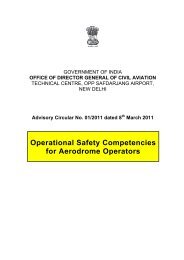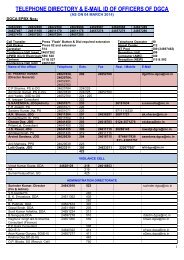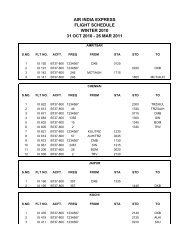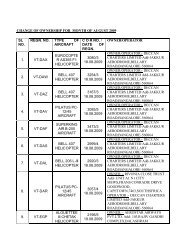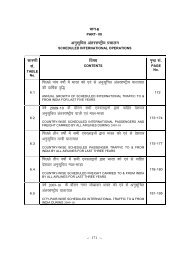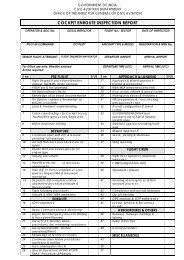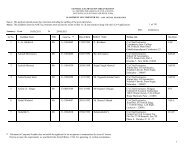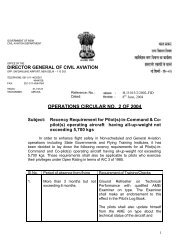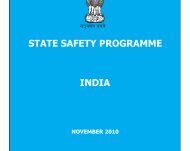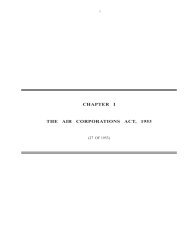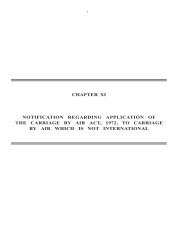Handbook on Medical Assessment of Civil Flight Crew - Directorate ...
Handbook on Medical Assessment of Civil Flight Crew - Directorate ...
Handbook on Medical Assessment of Civil Flight Crew - Directorate ...
You also want an ePaper? Increase the reach of your titles
YUMPU automatically turns print PDFs into web optimized ePapers that Google loves.
HANDBOOK ONMEDICAL ASSESSMENTOFCIVIL FLIGHT CREWIN INDIA(Please note that this document is for informati<strong>on</strong> purposes <strong>on</strong>lyand cannot be quoted as an authority)
FOREWORD<strong>Civil</strong> Aviati<strong>on</strong> in India is in the midst <strong>of</strong> a phase <strong>of</strong> rapid growth.Newer airlines are taking shape and the existing operators areexpanding their fleets and domains <strong>of</strong> activity. At present there areabout 4000 active commercial flight crew and an almost equal number <strong>of</strong>private licence holders in our country. In the coming years thesenumbers are set to grow steadily. Ensuring medical fitness <strong>of</strong> all flightcrew is not just a requirement <strong>of</strong> the Internati<strong>on</strong>al <strong>Civil</strong> Aviati<strong>on</strong>Organisati<strong>on</strong> agreement, to which India is a signatory; it is a matter <strong>of</strong>c<strong>on</strong>siderable public interest and importance.In India, medical examinati<strong>on</strong>s for all commercial flight crew arec<strong>on</strong>ducted at designated Indian Air Force <strong>Medical</strong> Centres, whereas forprivate licence holders medical examinati<strong>on</strong>s can be c<strong>on</strong>ducted byDGCA approved Class II Aviati<strong>on</strong> <strong>Medical</strong> Examiners. All medicalexaminati<strong>on</strong>s are c<strong>on</strong>ducted in accordance with ICAO Standards &Recommended Practices (Annex 1). However, ICAO medical standardsare not elaborate in several fields. Towards ensuring standardisati<strong>on</strong> inaeromedical disposal <strong>of</strong> flight crew with disease/ disabilities it isimperative that all centres and individual doctors be aware <strong>of</strong> existingprovisi<strong>on</strong>s in India. Doctors play a special role in ensuring c<strong>on</strong>tinuedmedical fitness <strong>of</strong> flight crew at various stages. Periodic medicalexaminati<strong>on</strong>s for maintaining validity <strong>of</strong> licence are <strong>on</strong>ly <strong>on</strong>e such area.Airline doctors play a crucial role in supervising follow up <strong>of</strong> flight crewwith medical disabilities, when they are c<strong>on</strong>sidered fit with limitati<strong>on</strong>s orspecific recommendati<strong>on</strong>s.This <str<strong>on</strong>g>Handbook</str<strong>on</strong>g> <strong>on</strong> <strong>Medical</strong> <strong>Assessment</strong> <strong>of</strong> <strong>Civil</strong> <strong>Flight</strong> crew in Indiahas been prepared to serve as a guideline to all doctors associated withcivil aviati<strong>on</strong> in India. It addresses medical assessment and standardsfor civil flight crew and also highlights the role and resp<strong>on</strong>sibilities <strong>of</strong>doctors in <strong>Civil</strong> Aviati<strong>on</strong>. I am c<strong>on</strong>fident that it will be very useful to allairline doctors, Indian Air Force <strong>Medical</strong> Officers and Class IIAeromedical Examiners in India.New Delhi (Mrs. P Bandopadhyay )15 March 2005 Air MarshalDirector General <strong>Medical</strong> Services (Air)
CONTENTSCHAPTER SUBJECT PAGE1. GENERAL INSTRUCTIONS 42. MEDICAL ASSESSMENT OFCIVIL AIRCREW IN INDIA113. ROLE AND RESPONSIBILITIES OFDOCTORS IN CIVIL AVIATION124. DISPOSAL OF SPECIFIC CASES 18AND SPECIFIC REQUIREMENTS5. APPENDICES 33
4CHAPTER - IGENERAL INSTRUCTIONSIntroducti<strong>on</strong>1. The Internati<strong>on</strong>al <strong>Civil</strong> Aviati<strong>on</strong> Organizati<strong>on</strong> was created to promote thesafe and orderly development <strong>of</strong> civil aviati<strong>on</strong> in the world.A specialized agency <strong>of</strong> the United Nati<strong>on</strong>s, it sets internati<strong>on</strong>al standardsand regulati<strong>on</strong>s necessary for safety, security, efficiency and regularity <strong>of</strong>air transport and serves as the medium for cooperati<strong>on</strong> in all fields <strong>of</strong>civil aviati<strong>on</strong> am<strong>on</strong>g its 185 c<strong>on</strong>tracting states. India is a signatory to the ICAOc<strong>on</strong>venti<strong>on</strong> and hence is committed to adopt at the minimum the ICAOStandards and Recommended Practices (SARPs).2. These SARP regulati<strong>on</strong>s have been promulgated in Annexes to theC<strong>on</strong>venti<strong>on</strong> that are amended from time to time when necessary.Each Annexure deals with a specific aspect <strong>of</strong> internati<strong>on</strong>al civil aviati<strong>on</strong>.Aviati<strong>on</strong> medicine is included mainly in Annex 1 (Pers<strong>on</strong>nel Licensing) and tosome degree in Annex 2 (Rules <strong>of</strong> the Air) and Annex 6 (Operati<strong>on</strong> <strong>of</strong> Aircraft).Standards and Recommended Practices are defined as follows:(a) Standard. Any specificati<strong>on</strong> for physical characteristics,c<strong>on</strong>figurati<strong>on</strong>, materiel, performance, pers<strong>on</strong>nel or procedure, theuniform applicati<strong>on</strong> <strong>of</strong> which is recognized as necessary for thesafety or regularity <strong>of</strong> internati<strong>on</strong>al air navigati<strong>on</strong>, and to whichC<strong>on</strong>tracting States will c<strong>on</strong>form in accordance with theC<strong>on</strong>venti<strong>on</strong>. In the event <strong>of</strong> impossibility <strong>of</strong> compliance,notificati<strong>on</strong> to the council <strong>of</strong> ICAO is compulsory under Article 38.(b) Recommended Practice. Any specificati<strong>on</strong> for physicalcharacteristics, c<strong>on</strong>figurati<strong>on</strong>, materiel, performance, pers<strong>on</strong>nel orprocedure, the uniform applicati<strong>on</strong> <strong>of</strong> which is recognized asdesirable in the interest <strong>of</strong> safety, regularity or efficiency <strong>of</strong>internati<strong>on</strong>al air navigati<strong>on</strong>, and to which C<strong>on</strong>tracting States willendeavor to c<strong>on</strong>form in accordance with the C<strong>on</strong>venti<strong>on</strong>.
5Different types <strong>of</strong> licenses3. Since the early days <strong>of</strong> aviati<strong>on</strong>, States have recognized the necessity tocheck the pr<strong>of</strong>iciency <strong>of</strong> pers<strong>on</strong>nel who perform activities, which unlessperformed properly, could jeopardize the safety <strong>of</strong> aviati<strong>on</strong>. Issuing a licensegenerally made the recogniti<strong>on</strong> <strong>of</strong> this competency. There are different types <strong>of</strong>licenses. Each <strong>on</strong>e grants specific privileges to the holder.(a)Pilot's Licenses(i) Student Pilot. While it is not formally a license,many C<strong>on</strong>tracting States issue a waiver allowing a studentpilot to fly solo before licensing. The medical fitness whenapplicable is <strong>of</strong>ten the least restrictive <strong>of</strong> all pilot licenses(Class 2). Therefore the medical examiner should beprepared to counsel the applicant against further time andexpense in pursuance <strong>of</strong> piloting ambiti<strong>on</strong>s if a medicalc<strong>on</strong>diti<strong>on</strong> is established which might prevent his acquisiti<strong>on</strong><strong>of</strong> a more senior pilot license.(ii) Private Pilot License - aeroplane (PPL -aeroplane). The most comm<strong>on</strong>ly held license permittingthe holder to fly an aeroplane other than pr<strong>of</strong>essi<strong>on</strong>ally.Private pilots usually fly small aeroplanes in visual flightc<strong>on</strong>diti<strong>on</strong>s.(iii) Private Pilot License - helicopter (PPL -helicopter). This is the helicopter license equivalent to thePPL - aeroplane.(iv) Glider or Micro Light Pilot License. The gliderpilot license permits the holder to act as pilot-in-command <strong>of</strong>any glider.(v) Free Ballo<strong>on</strong> Pilot License. The holder <strong>of</strong> thislicense is permitted to act as pilot-in-command <strong>of</strong> any freeballo<strong>on</strong>. This license is not in comm<strong>on</strong> use.(vi) Commercial Pilot License - Aeroplane (CPL -aeroplane). The CPL is the most junior license permittingthe holder to perform pr<strong>of</strong>essi<strong>on</strong>al duties either as a pilot-in-
6command <strong>of</strong> an aeroplane up to 5700 kg maximum take-<strong>of</strong>fmass or as co-pilot <strong>of</strong> any aircraft.(vii) Commercial Pilot License - Helicopter (CPL -Helicopter). This license is the helicopter equivalent to theCPL - aeroplane. In India comm<strong>on</strong>ly referred to as CHPL.(viii) Senior Commercial Pilot License - Aeroplane(SCPL - aeroplane). The license permitting the holder toperform pr<strong>of</strong>essi<strong>on</strong>al duties either as pilot-in-command <strong>of</strong>aircraft up to 20,000 kg maximum take-<strong>of</strong>f mass or as copilot<strong>of</strong> any aircraft. Not issued any more in India.(ix) Airline Transport Pilot License - Aeroplane (ATPL- aeroplane). The most senior pilot license permitting theholder to operate any aircraft either as pilot-in-command orco-pilot. The privileges <strong>of</strong> the instrument rating are includedin the ATPL - aeroplane. In India comm<strong>on</strong>ly referred to asALTP.(x) Airline Transport Pilot License - Helicopter (ATPL- helicopter). The helicopter equivalent <strong>of</strong> the ATPL -aeroplane. The instrument rating privileges, however, arenot included in the license. In India comm<strong>on</strong>ly referred to asALTP (H) or ATPH.The CPL, SCPL and ATPL for aeroplanes and helicopters are <strong>of</strong>ten referred toas pr<strong>of</strong>essi<strong>on</strong>al or commercial licenses.(b)Licenses for flight crewmembers other than pilot(i) <strong>Flight</strong> engineer. The license permitting the holder toperform the duty <strong>of</strong> a flight engineer when required byaircraft certificati<strong>on</strong> or operati<strong>on</strong>al regulati<strong>on</strong>.(ii)(iii)<strong>Flight</strong> navigator.<strong>Flight</strong> radio operator.
7These licenses are also in the pr<strong>of</strong>essi<strong>on</strong>al category, however these licenses,especially the last two are becoming obsolete and are seldom issued.(c)Licenses for pers<strong>on</strong>nel other than flight crewmembers(i) Air traffic c<strong>on</strong>troller license. The license in itselfcarries no privileges. These are c<strong>on</strong>ferred with additi<strong>on</strong>alratings to the license that actually characterizes the duty <strong>of</strong>an air traffic c<strong>on</strong>troller. In India, the DGCA does not issuelicences for Air Traffic C<strong>on</strong>trollers, as <strong>of</strong> now. <strong>Medical</strong>examinati<strong>on</strong>s are c<strong>on</strong>ducted by DGCA approved Class II/ IIIaeromedical examiners under the aegis <strong>of</strong> the employers –The Internati<strong>on</strong>al Airports Authority <strong>of</strong> India.(d) Annex I has provisi<strong>on</strong>s for other licenses (aircraftmaintenance mechanic, aer<strong>on</strong>autical stati<strong>on</strong> operator and flightoperati<strong>on</strong>s <strong>of</strong>ficer). However, these licenses have no medicalfitness requirement due to the nature <strong>of</strong> duties.Regulatory Authority4. In India the regulatory authority is the <strong>Directorate</strong> General <strong>of</strong> <strong>Civil</strong>Aviati<strong>on</strong> (DGCA) with its Headquarters at New Delhi. The Director General isresp<strong>on</strong>sible for all the activities <strong>of</strong> civil aviati<strong>on</strong> in India and directly reports tothe Secretary Ministry <strong>of</strong> <strong>Civil</strong> Aviati<strong>on</strong> and to the Minister <strong>of</strong> <strong>Civil</strong> Aviati<strong>on</strong>.Due to a pre-independence agreement, the IAF <strong>Medical</strong> Authorities have beenallotted the role <strong>of</strong> c<strong>on</strong>ducting all Class I medical assessments and for layingdown the <strong>Medical</strong> Standards for civil aircrew in the country. The DGMS (Air)is the <strong>Medical</strong> Advisor to the DGCA <strong>on</strong> all such medical issues. On behalf <strong>of</strong>the DGMS (Air) an IAF Aviati<strong>on</strong> Medicine Specialist –JDMS (<strong>Civil</strong> Aviati<strong>on</strong>)works as the medical assessor at DGCA and coordinates medical evaluati<strong>on</strong> atthe DGCA HQ.
8Forms to be used5. The initial issue medical examinati<strong>on</strong> is d<strong>on</strong>e <strong>on</strong> a special formdesignated as CA-34, all renewals are d<strong>on</strong>e <strong>on</strong> form CA-34A. The outcome <strong>of</strong>the medical examinati<strong>on</strong> is communicated to the aircrew <strong>on</strong> form CA-35.Based <strong>on</strong> the latter the DGCA then issues a <strong>Medical</strong> <strong>Assessment</strong>. The medicalassessment is required to be carried al<strong>on</strong>g with the licence and it shows thecurrent medical validity <strong>of</strong> the license holder. All medical documents aremaintained at the DGCA in folders referred to as Previous <strong>Medical</strong> Records(PMRs). The PMRs are to be called for by the medical boarding centre priorc<strong>on</strong>duct <strong>of</strong> the medical examinati<strong>on</strong>. The DGCA has now created a database <strong>of</strong>the summaries <strong>of</strong> medical records for all commercial flight crew and will beshortly making this data available to all IAF medical evaluati<strong>on</strong> centres.This will preclude despatch <strong>of</strong> PMRs to and from DGCA.<strong>Civil</strong> Aircrew <strong>Medical</strong> Examinati<strong>on</strong> Centres6. The applicant must meet certain appropriate medical requirements, whichare specified as three classes <strong>of</strong> <strong>Medical</strong> <strong>Assessment</strong>. The Licensing Authorityissues the license holder with the appropriate <strong>Medical</strong> <strong>Assessment</strong>, Class I,Class II or Class III. Class I medical assessment is for holders <strong>of</strong> pr<strong>of</strong>essi<strong>on</strong>allicenses, Class II medical assessments are applicable for all other flyinglicenses. A Class III medical assessment is for ATC Officers. The variousrequirements for each class are laid down in the medical standards.7. There are in all 11 IAF <strong>Civil</strong> Aircrew <strong>Medical</strong> Examinati<strong>on</strong> Centresspread all over the country entrusted with the tasks <strong>of</strong> civil aircrew medicalexaminati<strong>on</strong>s for Class I medical assessments. These 11 centres are appendedbelow: -(a)(b)(c)(d)(e)(f)(g)AFCME, New DelhiIAM, BangaloreAFS AmbalaAFS BarrackporeAFS BegumpetAFS MumbaiAFS Pune
9(h)(j)(k)(l)AFS ManauriAFS TambaramAFS JorhatAFS Kanpur8. A panel <strong>of</strong> Class II and III <strong>Medical</strong> examiners c<strong>on</strong>ducts all Class II & IIImedical examinati<strong>on</strong>s. These doctors besides having a basic MBBS degreerecognized by the <strong>Medical</strong> Council <strong>of</strong> India also need to have d<strong>on</strong>e sometraining in the subject <strong>of</strong> Aviati<strong>on</strong> Medicine. All medical examinati<strong>on</strong>sc<strong>on</strong>ducted at any IAF <strong>Civil</strong> Aircrew <strong>Medical</strong> Examinati<strong>on</strong> centres and alsoClass II & III medical assessments c<strong>on</strong>ducted by private doctors are subject t<strong>of</strong>inal assessment and approval by the JDMS (CA) <strong>on</strong> behalf <strong>of</strong> the DGMS (Air).(Note: Class II & III medical examinati<strong>on</strong>s can also be c<strong>on</strong>ducted by Class Icentres, though such centres may refuse to entertain Class II & III medicalexaminati<strong>on</strong>s depending <strong>on</strong> workload and service exigencies).9. When an aircrew is declared temporarily or permanently unfit for issue orrenewal <strong>of</strong> license, the reas<strong>on</strong> for unfitness shall be clearly endorsed <strong>on</strong> the CA34\34A and CA 35. One copy <strong>of</strong> the CA 35 shall be handed over to theindividual and his/ her signature obtained as a token <strong>of</strong> having received themedical disposal certificate.Currency <strong>of</strong> <strong>Medical</strong> <strong>Assessment</strong>10. The durati<strong>on</strong> <strong>of</strong> the period <strong>of</strong> currency <strong>of</strong> a <strong>Medical</strong> <strong>Assessment</strong> shall bein accordance with the provisi<strong>on</strong>s laid down by DGCA. In India the period <strong>of</strong>currency is listed below and shall begin <strong>on</strong> the date the CA 35 is issued by themedical examinati<strong>on</strong> centre. This is laid down in DGCA AIC 06 / 2001.24 m<strong>on</strong>ths for the student pilot license24 m<strong>on</strong>ths for the free ballo<strong>on</strong>/microlite pilot license24 m<strong>on</strong>ths for the glider pilot license(after age 40 will become 12 m<strong>on</strong>ths)24 m<strong>on</strong>ths for the private pilot – aero plane/helicopter license(after age 40 will become 12 m<strong>on</strong>ths)12 m<strong>on</strong>ths for the commercial pilot – aero plane/helicopter license
10(after age 40 will become 6 m<strong>on</strong>ths)06 m<strong>on</strong>ths for the senior commercial pilot – aero plane/helicopter license06 m<strong>on</strong>ths for the airline transport pilot – aero plane/helicopter license12 m<strong>on</strong>ths for the flight navigator license12 m<strong>on</strong>ths for the flight engineer license12 m<strong>on</strong>ths for the flight radio operator license24 m<strong>on</strong>ths for the air traffic c<strong>on</strong>troller license
11CHAPTER –2ASSESSMENT OF CIVIL AIRCREW IN INDIAThe Indian <strong>Medical</strong> Standards1. Two basic principles are essential when assessing an applicant's medicalfitness for aviati<strong>on</strong> duties namely:(a) The applicant should be physically and mentally capable <strong>of</strong>performing the duties <strong>of</strong> the license or rating applied for or held.(b) There should be no medical reas<strong>on</strong>s, which make the applicantliable to incapacitati<strong>on</strong> while performing duties; to a degree thatflight safety might be jeopardized.2. The Indian <strong>Medical</strong> standards have been defined by the <strong>Civil</strong> Aviati<strong>on</strong>Requirement (CAR) Secti<strong>on</strong> 7, <strong>Flight</strong> <strong>Crew</strong> Licensing, Series C, Part-I, Issue 1,dated 26 August 1999 as c<strong>on</strong>tained in Appendix ‘A’ to this handbook.3. The Indian <strong>Medical</strong> Standards as referred to in the CAR rely heavily <strong>on</strong>the provisi<strong>on</strong>s given in the ICAO Annexure 1. Details <strong>of</strong> aeromedical disposal<strong>of</strong> flight crew with disease/ disability are laid down in Aer<strong>on</strong>autical Informati<strong>on</strong>Circulars (AIC) issued by DGCA and <strong>Medical</strong> Informati<strong>on</strong> Circulars (MIC)issued by DGMS (Air). The AICs and MICs in force are to ensurestandardisati<strong>on</strong> <strong>of</strong> aeromedical disposal by various aeromedical centres as far aspossible. These circulars basically exploit the flexibility clause <strong>of</strong> para 1.2.4.8<strong>of</strong> Annex 1.Scale <strong>of</strong> Equipment4. For IAF <strong>Medical</strong> Evaluati<strong>on</strong> Centres, a scale <strong>of</strong> medical equipment forc<strong>on</strong>duct <strong>of</strong> these medical evaluati<strong>on</strong>s is provided. For this purpose scale ‘Y’ isauthorized wherever medical board for civil aircrew is held.
12CHAPTER -3ROLE AND RESPONSIBILITIES OF DOCTORS IN CIVIL AVIATIONIntroducti<strong>on</strong>1. Where a medical deficiency exists, the extent to which air safety isaffected is the vital factor, rather than the extent to which failure to attain themedical requirements is capable <strong>of</strong> being compensated. In some cases thequesti<strong>on</strong> <strong>of</strong> compensati<strong>on</strong> for a deficiency will be irrelevant, for example wherethe risk is <strong>on</strong>e <strong>of</strong> sudden incapacitati<strong>on</strong> rather than inability to carry out arequired task physically. In other cases, the ability to compensate, for example,for an orthopaedic dysfuncti<strong>on</strong> may be an important factor in theover-all assessment <strong>of</strong> the effect <strong>on</strong> flight and public safety. Previouslyacquired skill and experience may similarly be irrelevant or important to theover-all assessment <strong>of</strong> the safety risk. In India the DGCA has laid down therestricti<strong>on</strong>s to be imposed <strong>on</strong> aircrew with certain disabilities, keeping in mindthe picture <strong>of</strong> flight safety. Licensing Circular 1/2000 (Appendix D) issued byDGCA specifies <strong>on</strong> the restricti<strong>on</strong>s in employment for flight crew withlimitati<strong>on</strong>s due to medical reas<strong>on</strong>s.2. To ensure careful implementati<strong>on</strong> <strong>of</strong> laid down policy it is vital that allc<strong>on</strong>cerned understand their own resp<strong>on</strong>sibilities as well as those <strong>of</strong> others in theexisting medical system in India.Role <strong>of</strong> <strong>Medical</strong> Assessor at DGCA3. The Director General <strong>Medical</strong> Services <strong>of</strong> the Air Force[DGMS (Air)] is the medical adviser to the DGCA. On behalf <strong>of</strong> the DGMS(Air), the JDMS (CA) works as the medical assessor at DGCA. This specialistin Aviati<strong>on</strong> Medicine scrutinises all medical records <strong>of</strong> flight crew and approvesthem <strong>on</strong> behalf <strong>of</strong> the DGCA. Complex cases requiring aeromedical decisi<strong>on</strong>makingincluding all cases <strong>of</strong> Permanent Unfitness, appeal cases and where themedical assessor disagrees with the opini<strong>on</strong> <strong>of</strong> aeromedical centres/ examinersare referred to the <strong>of</strong>fice <strong>of</strong> DGMS (Air) for final decisi<strong>on</strong>. The medicalassessor is also resp<strong>on</strong>sible for processing requirements for amendments to
13existing policy <strong>of</strong> aeromedical disposal in light <strong>of</strong> recent advances and ICAOpolicy. These amendments are issued by the <strong>of</strong>fice <strong>of</strong> DGCA/ DGMS (Air).4. Apart from the primary role as menti<strong>on</strong>ed above, the medical assessor isalso resp<strong>on</strong>sible for the following:-(a)<strong>Medical</strong> investigati<strong>on</strong> <strong>of</strong> civil aircraft accidents.(b) Facilitating Procurement <strong>of</strong> medical equipment and expendablesfor IAF aeromedical centres from DGCA.(c) Approving civil doctors who have underg<strong>on</strong>e a certified course inAviati<strong>on</strong> Medicine <strong>on</strong> the DGCA Class II Aeromedical Examiners paneland reviewing this approval from time to time.(d) Organising expert lectures/ CME programs in Aviati<strong>on</strong> Medicinefor Airline Doctors and Class II aeromedical examiners through theDGCA.(e) Maintaining and updating <strong>of</strong> the <strong>Medical</strong> hyperlink <strong>on</strong> the DGCAwebsite. The DGCA website http://dgca.nic.in has a “<strong>Medical</strong>” hyperlink<strong>on</strong> the home page. The following informati<strong>on</strong> is available <strong>on</strong> this link:-(i)Online informati<strong>on</strong> for Class I licence holders about:-(aa)Acti<strong>on</strong> <strong>on</strong> request for transfer <strong>of</strong> PMR(ab) Full details <strong>of</strong> <strong>Medical</strong> <strong>Assessment</strong> after approval atDGCA.(ii) List <strong>of</strong> DGCA approved Class II & III AeromedicalExaminers with their addresses and teleph<strong>on</strong>e numbers (whereprovided).(iii) Full text <strong>of</strong> relevant CAR/ AICs/ Licensing Circulars issuedby DGCA.
14Role <strong>of</strong> Airline Doctors5. The Airline <strong>Medical</strong> Departments play a crucial role in ensuringc<strong>on</strong>tinued medical fitness <strong>of</strong> their flight crew and ground crew. The role <strong>of</strong> theairline doctors in this area is vital for flight safety and safeguarding <strong>of</strong> publicinterest. The airline medical departments must ensure:-(a) <strong>Medical</strong> fitness <strong>of</strong> all flight crew and ground crew engaged inflying operati<strong>on</strong>s. This entails daily pre-flight medical check ups andrandom breath analysis for alcohol.(b) C<strong>on</strong>ducting specific medical examinati<strong>on</strong>s as recommended by theDGCA medical assessment/ CA 35 issued by the IAF aeromedical centrese.g. periodic record <strong>of</strong> Blood Pressure, requirement <strong>of</strong> specificinvestigati<strong>on</strong>s sought at next medical review, and periodic weight record.(c) To scrutinise the medical assessment <strong>of</strong> fitness issued by DGCA inrespect <strong>of</strong> flight crew <strong>of</strong> the c<strong>on</strong>cerned airline. Permissi<strong>on</strong> for return t<strong>of</strong>lying duties after period <strong>of</strong> unfitness is to be granted after necessaryapproval from DGCA has been obtained and perused by resp<strong>on</strong>siblemedical <strong>of</strong>ficer <strong>of</strong> the airlines.(d) Correct rostering <strong>of</strong> flight crew with medical limitati<strong>on</strong>s like “fit t<strong>of</strong>ly as co-pilot <strong>on</strong>ly” or “fit to fly as P-I-C al<strong>on</strong>g with qualifiedexperienced pilot <strong>on</strong>ly” in liais<strong>on</strong> with their respective Operati<strong>on</strong>sDepartment. (Refer Licensing Circular 1/2000 – Appendix B).(e) Implementati<strong>on</strong> <strong>of</strong> recommendati<strong>on</strong>s or medical advice given bythe DGCA medical assessment/ CA 35 issued by IAF aeromedical centrese.g. mandatory wearing <strong>of</strong> specific corrective glasses and possessi<strong>on</strong> <strong>of</strong>spare set <strong>of</strong> glasses by such flight crew.(f) To refer all cases <strong>of</strong> decrease in medical fitness noticed or reportedam<strong>on</strong>g flight crew to the JDMS (CA) at DGCA, for decisi<strong>on</strong> regardingrequirement for special/ review medical examinati<strong>on</strong>s at IAF aeromedicalcentres. In this regard the provisi<strong>on</strong>s <strong>of</strong> Para 4.5 and 4.6 <strong>of</strong> <strong>Civil</strong>Aviati<strong>on</strong> Requirements (CAR), Secti<strong>on</strong> 7, Series ‘C’ Part I and Para1.2.6.1 and 1.2.6.1.1 <strong>of</strong> Annex 1 <strong>of</strong> Internati<strong>on</strong>al Standards <strong>of</strong> ICAOshould be complied with. In accordance with these provisi<strong>on</strong>s theprivileges <strong>of</strong> aircrew should not be exercised the moment they are aware
15<strong>of</strong> any decrease in their medical fitness. This is in the interest <strong>of</strong> publicsafety. It is incumbent up<strong>on</strong> the airline medical management to take stepsto ensure that this is implemented.(g) Training in Aviati<strong>on</strong> Medicine for all airline doctors at Institute <strong>of</strong>Aerospace Medicine Bangalore. This is c<strong>on</strong>sidered essential for alldoctors to understand the nuances and critical areas in the Aviati<strong>on</strong>envir<strong>on</strong>ment. All airline doctors should be further encouraged to attendregular CME programs/ training courses in Aviati<strong>on</strong> Medicine c<strong>on</strong>ductedby DGCA/ IAF/ Indian Society <strong>of</strong> Aerospace Medicine.Role <strong>of</strong> Class II Aeromedical Examiners6. DGCA approved Class II Aeromedical Examiners perform the veryimportant functi<strong>on</strong> <strong>of</strong> medical examinati<strong>on</strong> <strong>of</strong> Student Pilots, Private Pilots,Glider Pilots, Ballo<strong>on</strong> Pilots etc. All such doctors are required to undergomandatory training in Aviati<strong>on</strong> Medicine at IAM, Bangalore. The medicalexaminati<strong>on</strong>s performed by such aeromedical examiners are c<strong>on</strong>ducted for and<strong>on</strong> behalf <strong>of</strong> the Govt <strong>of</strong> India. It is therefore imperative that such medicalexaminati<strong>on</strong>s be c<strong>on</strong>ducted in a pr<strong>of</strong>essi<strong>on</strong>al manner and with the greatest sense<strong>of</strong> integrity and fairness. All Class II aeromedical examiners must familiarisethemselves with the laid down regulati<strong>on</strong>s governing the same.7. Class II Aeromedical Examiners must possess a copy <strong>of</strong> ICAO Standardsand Recommended Practices Annex 1. Chapter 6 <strong>of</strong> this document deals with<strong>Medical</strong> Provisi<strong>on</strong>s for Licensing. This document may be obtained <strong>on</strong> paymentfrom:Oxford Book and Stati<strong>on</strong>ery Co.Scindia HouseNew Delhi 110001Tele: 011-23315308Fax : 011-51517559or17, Park StreetKolkata8. The DGCA issues <strong>Civil</strong> Aviati<strong>on</strong> Requirements (CARs) and Aer<strong>on</strong>auticalInformati<strong>on</strong> Circulars (AICs) <strong>on</strong> medical subjects from time to time. SimilarlyDGMS (Air) issues guidelines as <strong>Medical</strong> Informati<strong>on</strong> Circulars (MICs) to
16Aeromedical Centres <strong>of</strong> the IAF for c<strong>on</strong>duct <strong>of</strong> Class I medical examinati<strong>on</strong>s forpr<strong>of</strong>essi<strong>on</strong>al flight crew. Relevant copies <strong>of</strong> the all such requirements andcirculars are placed as appendices to this document.9. Class II Aeromedical Examiners must record details <strong>of</strong> medicalexaminati<strong>on</strong>s <strong>of</strong> the flight crew meticulously <strong>on</strong> the relevant formsCA 34/ 34 A. Details <strong>of</strong> disease/ disability detected must be endorsed <strong>on</strong> theforms at appropriate columns <strong>on</strong> the forms. Opini<strong>on</strong> <strong>of</strong> c<strong>on</strong>cerned specialistsshould be attached to the medical examinati<strong>on</strong> forms. All investigati<strong>on</strong> reportsas required for initial and renewal medical examinati<strong>on</strong>s must be enclosed withthe forms before submitting the same to the JDMS (CA) at DGCA TechnicalCentre, Opp Safdarjung Airport, New Delhi 110 003 for approval. In case <strong>of</strong>any doubts regarding fitness <strong>of</strong> a particular flight crew, no certificate <strong>of</strong> fitnessmay be given to the individual and flight crew may be informed that the <strong>of</strong>fice<strong>of</strong> JDMS (CA), DGCA, would communicate the final decisi<strong>on</strong>.10. Prior to despatch <strong>of</strong> the medical examinati<strong>on</strong> forms to DGCA,Aeromedical Examiners must carefully check the forms for accuracy andcompleti<strong>on</strong>. A checklist for initial medical examinati<strong>on</strong>s for award <strong>of</strong> SPL/ PPL<strong>on</strong> form CA 34 is as follows:-(a) Ensure completi<strong>on</strong> <strong>of</strong> Part I <strong>of</strong> the form by the applicant in yourpresence and countersign the same. Specially look for history <strong>of</strong>Epilepsy, Diabetes Mellitus and heart disease in the individual applicantor his parents/ siblings and investigate accordingly.(b) Sign and stamp a recent photograph <strong>of</strong> the applicant in the spaceprovided.(c) Ensure meticulous completi<strong>on</strong> <strong>of</strong> all columns in Part II <strong>of</strong> the formafter medical examinati<strong>on</strong>. Individual specialist opini<strong>on</strong>s forOphthalmology and ENT are not mandatory, but if obtained, must besigned by the c<strong>on</strong>cerned specialist.(d) Attach the following essential investigati<strong>on</strong> reports :-(i)(ii)(iii)(iv)Resting ECG with tracingX Ray Chest PA View with film and reportBlood Hb, TLC, DLC reportUrine RE report
17(v)(vi)Pure T<strong>on</strong>e AudiogramAny other medical investigati<strong>on</strong> c<strong>on</strong>ducted(e) Attach copy <strong>of</strong> Cockpit Test Report issued by CFI <strong>of</strong> the FlyingClub/ Academy.(f) The following endorsements, (as applicable) under ‘Findings andRecommendati<strong>on</strong>s <strong>of</strong> the <strong>Medical</strong> Examiner/<strong>Medical</strong> Board’ <strong>on</strong> CA 34/34A should be made in RED ink :-(a)Fit Class II/ III <strong>Medical</strong> <strong>Assessment</strong>(b) Fit to fly as Pilot-in-Command al<strong>on</strong>g with QualifiedExperienced Pilot(c)(d)(e)Fit to fly as Co-Pilot <strong>on</strong>lyTemporary UNFIT for flyingPermanently UNFIT for flying11. Class II Aeromedical Examiners must advise the prospective flightcrew about any borderline disabilities that they detect and which may precludefitness for a Class I medical examinati<strong>on</strong> at a later date. Young individuals whowant to take up a career in aviati<strong>on</strong> as a flight crew should not assume that bymeeting Class II medical examinati<strong>on</strong> standards, they will automatically bemedically fit for commercial aviati<strong>on</strong> licences as well.12. Class II Aeromedical Examiners must regularly update their knowledgein the field <strong>of</strong> Aviati<strong>on</strong> Medicine and keep abreast with any changes in policyissued by the DGCA. The doctors must attend nati<strong>on</strong>al c<strong>on</strong>ferences in Aviati<strong>on</strong>Medicine and CME programs in the subject c<strong>on</strong>ducted by DGCA/ IAF fromtime to time. On individual cases, the aeromedical examiners may c<strong>on</strong>sult theJDMS (CA) at DGCA <strong>on</strong> any working day between 1430 and 1700 hrs at:-Joint Director <strong>Medical</strong> Services (<strong>Civil</strong> Aviati<strong>on</strong>)Office <strong>of</strong> the DGCADGCA Technical centreOpp Safdarjung AirportNew Delhi 110 003.Ph<strong>on</strong>e : 011- 24610629 (Direct); 011-24622495 Extn 312Email: adgms.dgca@nic.in
18CHAPTER 4DISPOSAL OF SPECIFIC CASES AND SPECIFIC REQUIREMENTSDISPOSAL OF CASES OF IHDReference: AIC 28/99 (including amendments No 1 & 2 issued in 2000 & 2004)1. In light <strong>of</strong> the recent advances in our knowledge <strong>of</strong> cor<strong>on</strong>ary arterydisease, its management and prognosis, and our accumulated data andexperience, it has become necessary to review and revise the guidelines for theemployability <strong>of</strong> aircrew with CAD. These guidelines are laid down in thefollowing paragraphs.2. Classificati<strong>on</strong> and criteria for diagnosis(a) IHD Asymptomatic. ECG abnormality suggestive <strong>of</strong> IHDdetected during routine examinati<strong>on</strong> in an asymptomatic individual.(i) Minimal/Insignificant CAD. No single cor<strong>on</strong>ary arterylesi<strong>on</strong> is greater than 50% <strong>of</strong> the diameter <strong>of</strong> the lumen. Lesi<strong>on</strong>sgreater than 30% but less than 50% in more than <strong>on</strong>e cor<strong>on</strong>aryartery or tandem lesi<strong>on</strong> in the same artery will be assessed <strong>on</strong> caseto-casebasis. A stress Technetium Scan test will be carried out ifc<strong>on</strong>sidered necessary.(ii) Significant CAD. Any lesi<strong>on</strong> in a cor<strong>on</strong>ary artery with50% or more stenosis <strong>of</strong> diameter.(b)IHD-Angina Pectoris(i) Stable Angina. Angina that is usually precipitated byexerti<strong>on</strong>. There should not have been any change in frequency ordurati<strong>on</strong> <strong>of</strong> angina or ease <strong>of</strong> relief <strong>of</strong> anginal pain during the past60 days.(ii) Unstable Angina. New <strong>on</strong>set angina/angina occurringwith increased frequency or durati<strong>on</strong> or angina at rest.
19(iii) Variant Angina (Prinzmetal Angina). Usually occurs atrest and ECG during the episode exhibits transient ST segmentelevati<strong>on</strong>.(iv) Angina with normal cor<strong>on</strong>ary arteries (Syndrome X).Classical angina pectoris with normal epicardial cor<strong>on</strong>ary arteriesas assessed by cor<strong>on</strong>ary angiography. Causes include inadequatevasodilator reserve, intramyocardial muscle bridges and smallvessel cor<strong>on</strong>ary artery disease.(c)IHD-Myocardial Infarcti<strong>on</strong>(i) N<strong>on</strong>-transmural (Sub endocardial infarcti<strong>on</strong>/n<strong>on</strong>-q waveinfarcti<strong>on</strong>). Individuals showing evidence <strong>of</strong> Myocardial musclenecrosis with elevati<strong>on</strong> <strong>of</strong> serum cardiac enzymes during acutephase <strong>of</strong> illness and no evidence <strong>of</strong> pathological q wave <strong>on</strong> ECG.(ii) Transmural (Q-wave): Individuals showing evidence <strong>of</strong>myocardial muscle necrosis with elevati<strong>on</strong> <strong>of</strong> serum cardiacenzymes during acute phase <strong>of</strong> illness and development <strong>of</strong>pathological q wave <strong>on</strong> ECG.(d) IHD- Post PTCA/CABGS. Cases <strong>of</strong> IHD who have underg<strong>on</strong>eMyocardial revascularisati<strong>on</strong> procedure.<strong>Assessment</strong> <strong>of</strong> IHD Cases3. Aircrew with asymptomatic IHD clinical group (a) will be referred toAFCME <strong>on</strong>ly for complete cardiac evaluati<strong>on</strong>. The following investigati<strong>on</strong>s willbe carried out as c<strong>on</strong>sidered necessary:(a)(b)(c)(d)(e)(f)(g)Biochemical pr<strong>of</strong>ileTMTHolter m<strong>on</strong>itor ringECHO Cardiography including Stress ECHOStress MUGAStress ThalliumCor<strong>on</strong>ary Angiography CART
204. Disposal: IHD Asymptomatic(a) If CART is normal and there is no associated abnormality egHypertensi<strong>on</strong>, Hypertrophic Cardiomyopathy, Aortic valvular disease,Myocarditis etc the aircrew will be certified fit.(b) Cases with minimal insignificant CAD will be certified fit withrestricti<strong>on</strong> to fly as PIC al<strong>on</strong>gwith a qualified P2 <strong>on</strong>ly. All renewalmedical examinati<strong>on</strong> will be c<strong>on</strong>ducted at IAM/AFCME <strong>on</strong>ly. Thesecases will undergo Stress thallium every year. CART may be repeated asindicated.(c) Cases <strong>of</strong> significant CAD in whom myocardial revascularisati<strong>on</strong>procedure is not indicated or not performed or who are advised <strong>on</strong>lymedical treatment, will be grounded. Cases requiring myocardialrevascularisati<strong>on</strong> procedures will be disposed as indicated later.5. Disposal <strong>of</strong> IHD: Angina Pectoris. All cases <strong>of</strong> angina as well assignificant cor<strong>on</strong>ary artery disease will be observed <strong>on</strong> ground from thedate <strong>of</strong> initial diagnosis for a minimum period <strong>of</strong> 12 m<strong>on</strong>ths. They will becategorized as “temporary Unfit” in two spells <strong>of</strong> 06 m<strong>on</strong>ths each.Thereafter, these will be assessed as per para 5 (a), (b) and (c) <strong>of</strong> AIC28/99.(a) All cases <strong>of</strong> angina will be observed <strong>on</strong> ground for a minimumperiod <strong>of</strong> 12 m<strong>on</strong>ths. Certificati<strong>on</strong> will be c<strong>on</strong>sidered <strong>on</strong>ly after12 m<strong>on</strong>ths <strong>of</strong> the initial diagnosis provided the following criteria are met.(i)Individual is asymptomatic and effort tolerance is normal.(ii) Modifiable risk factors and complicati<strong>on</strong>s, if any, are underc<strong>on</strong>trol/stabilised.(iii) Maximal TMT, Sress MUGA & Stress Thallium do notshow evidence <strong>of</strong> reversible myocardial ischaemia.(iv) Holter m<strong>on</strong>itoring does not reveal any episode <strong>of</strong> silentmyocardial ischaemia or significant arrhythmia.(v) ECHO shows normal left ventricular functi<strong>on</strong> and nosignificant regi<strong>on</strong>al wall abnormality.
21(vi)Not <strong>on</strong> cardioactive drugs.(vii) CART and other hemodynamic studies show cor<strong>on</strong>aryarteries to be normal or with minimal\insignificant lesi<strong>on</strong>.(b) The diagnosis in such cases will need to be appropriately revised.Such cases will be certified fit to fly as PIC al<strong>on</strong>g with a qualified P2<strong>on</strong>ly. These cases will be followed up annually at IAM\AFCME. StressThallium will be repeated every year and CART will be repeated asindicated.(c) Aircrew with Angina Pectoris and significant CAD may bec<strong>on</strong>sidered for up-gradati<strong>on</strong> provided they have underg<strong>on</strong>e myocardialrevascularisati<strong>on</strong> procedures. Disposal <strong>of</strong> these cases will be as givenlater. (Disposal after PTCA/CABGS)6. Disposal <strong>of</strong> IHD: Myocardial Infarcti<strong>on</strong> (N<strong>on</strong>-transmural as well asTransmural Myocardial Infarcti<strong>on</strong>). Aircrew with Myocardial Infarcti<strong>on</strong> willbe grounded. AFCME/IAM may <strong>on</strong> a case to case basis recommend cases <strong>of</strong>Myocardial Infarcti<strong>on</strong> for award <strong>of</strong> P1 status to fly al<strong>on</strong>g with a qualified P2<strong>on</strong>ly (with any other specified restricti<strong>on</strong>s) not less than 12 m<strong>on</strong>ths after theepisode provided all the following criteria are met:(a)Individual is asymptomatic and his effort tolerance is normal.(b) Modifiable risk factors and complicati<strong>on</strong>s if any arecorrected/stabilized.(c)Maximal TMT, Stress MUGA, Stress Thallium scan does not showevidence <strong>of</strong> reversible myocardial ischaemia.(d) Holter m<strong>on</strong>itoring does not reveal any episode <strong>of</strong> silent MyocardialIschaemia or significant arrhythmia.(e) ECHO shows normal LV functi<strong>on</strong>s and no significant regi<strong>on</strong>al wallmoti<strong>on</strong> abnormality.(f) The following groups <strong>of</strong> drugs are permitted for c<strong>on</strong>siderati<strong>on</strong> <strong>of</strong>flying fitness provided all other parameters are met as required:-(i)(ii)DispirinStatins/ fibric acid derivatives am<strong>on</strong>g lipid lowering drugs.
22(iii) Permitted Anti-hypertensive drugs including diuretics, betablockers,ACE Inhibitors and Calcium Channel blockers in dosagesas allowed.(g) CART and other hemodynamic studies show cor<strong>on</strong>ary arteriesother than the infarct related vessel to be normal or with minimal lesi<strong>on</strong>(h) These cases will be reviewed every 6 m<strong>on</strong>ths at AFCME/ IAM .7. Disposal after Myocardial Revascularizati<strong>on</strong> Procedures. For thoseaircrew requiring revascularisati<strong>on</strong> procedure, it will be mandatory to undergothe same within 1 year period from c<strong>on</strong>siderati<strong>on</strong> <strong>of</strong> flying status.An aircrewunwilling and or not undergoing a revascularisati<strong>on</strong> procedure in this period <strong>of</strong>1 year will then be declared “Permanently Unfit” and no further review will beentertained with respect to this c<strong>on</strong>diti<strong>on</strong>. For the observati<strong>on</strong> period <strong>of</strong> 09m<strong>on</strong>ths post PTCA, the aircrew will be assessed as “Temporary Unfit” for 06m<strong>on</strong>ths followed by 03 m<strong>on</strong>ths. For observati<strong>on</strong> period <strong>of</strong> 12 m<strong>on</strong>ths postCABG, the aircrew will be categorized as “Temporary Unfit” for two spells <strong>of</strong>06 m<strong>on</strong>ths each. Selected cases fulfilling the laid down criteria will bec<strong>on</strong>sidered for certificati<strong>on</strong>.(a)PTCA.(i) A minimum period <strong>of</strong> 9 m<strong>on</strong>ths should have elapsed sincethe procedure. He should have remained aymptomatic andmaintained functi<strong>on</strong>al class I (NYHA) for at least 6 m<strong>on</strong>ths.(ii) They should not have any associated disease like DM,Hypertensi<strong>on</strong>, Peripheral vascular disease or metabolic disorder.The modifiable risk factors should have been corrected.(iii) There should be no evidence <strong>of</strong> significant reversibleMI/arrhythmia/c<strong>on</strong>ducti<strong>on</strong> defects appearing <strong>on</strong> TMT. The subjectshould satisfactorily complete a symptom free limited exerciseECG evaluati<strong>on</strong> (usually Bruce stage 3 or more).(iv) 24 Hours Ambulatory m<strong>on</strong>itoring Holter should not revealany significant arrhythmia, c<strong>on</strong>ducti<strong>on</strong> defect or silent ischaemicepisode.(v) Radi<strong>on</strong>uclide Venticulography should reveal normalventricle size, shape and functi<strong>on</strong>s. Global left ventricle ejecti<strong>on</strong>
23fracti<strong>on</strong> should be normal i.e. more than or equal to 50% showingfurther rise with exercise.(vi) Repeat CART not earlier than 8 m<strong>on</strong>ths following procedureshould show results <strong>of</strong> successful cor<strong>on</strong>ary angioplasty with noevidence <strong>of</strong> a re-stenosis. There should be no lesi<strong>on</strong> restricting theluminal diameter to 50% or more in any epicardial artery.(vii) Planar Thallium Myocardial Perfusi<strong>on</strong> scan should revealnormal left ventricular size, absence <strong>of</strong> stress induced perfusi<strong>on</strong>defect or washout abnormality in any part <strong>of</strong> myocardium.(viii) Those cases who fulfill the above criteria will be c<strong>on</strong>sideredfit for flying as P1 al<strong>on</strong>g with a qualified P2 <strong>on</strong>ly with any otherrestricti<strong>on</strong>. They will be reviewed at least <strong>on</strong>ce in 12 m<strong>on</strong>ths atAFCME. Investigati<strong>on</strong>s including Stress Thallium and CART willbe carried out as c<strong>on</strong>sidered necessary by the cardiologist <strong>of</strong> theestablishment. Cases who have suffered a myocardial infarcti<strong>on</strong>will not be c<strong>on</strong>sidered for flying till 12 m<strong>on</strong>ths after the episode <strong>of</strong>infarcti<strong>on</strong>.(b) CABGS. Aircrew who have underg<strong>on</strong>e CABGS procedure may bec<strong>on</strong>sidered for certificati<strong>on</strong> provided they meet the following criteria:(i). Minimum period <strong>of</strong> 12 m<strong>on</strong>ths should have elapsed since theprocedure. He should have maintained functi<strong>on</strong>al class I (NYHA)for at least 6 m<strong>on</strong>ths and had been <strong>on</strong> no cardioactive drugs exceptdispirin or persantin.(ii) There should be no associated disease like Hypertensi<strong>on</strong>,DM, Peripheral vascular disease or metabolic disorder.All modifiable risk factors should have been corrected.(iii) There should have been no significant left main stemstenosis (50% or above)(iv) The subject should be able to complete a symptom-limitedexercise ECG satisfactorily (usually Bruce stage 3 or more).It should not reveal reversible myocardial ischaemia, leftventricular dysfuncti<strong>on</strong>, significant arrhythmias or fresh c<strong>on</strong>ducti<strong>on</strong>defects.
24(v) Radi<strong>on</strong>uclide Ventriculography should dem<strong>on</strong>stratean ejecti<strong>on</strong> fracti<strong>on</strong> <strong>of</strong> equal or more than 50 %.(vi) A Thallium scan should show no perfusi<strong>on</strong> defect or LVDysfuncti<strong>on</strong>.(vii) Colour Doppler echography evaluati<strong>on</strong> should reveal nostructural disease <strong>of</strong> the heart, left ventricular dysfuncti<strong>on</strong> orsignificant regi<strong>on</strong>al wall moti<strong>on</strong> abnormality.(viii) Holter m<strong>on</strong>itoring for 24 hours should not reveal anyabnormality <strong>of</strong> rate, rhythm, and silent ischemic episodes.(ix) Repeat CART with left ventriculography should objectivelydocument all grafts patent, no significant proximal disease and nolesi<strong>on</strong> <strong>of</strong> more than 50 % in the remaining ungrafted nativecirculati<strong>on</strong>. Left ventriculography must dem<strong>on</strong>strate normalLV size, shape, c<strong>on</strong>tractility and functi<strong>on</strong>s. There should beno significant mitral regurgitati<strong>on</strong>.(x) Cases c<strong>on</strong>sidered fit based <strong>on</strong> the above criteria would becertified fit P1 status to fly with a qualified P2 <strong>on</strong>ly with any otherrestricti<strong>on</strong>. They will be reviewed at AFCME at least <strong>on</strong>ce in12 m<strong>on</strong>ths. Investigati<strong>on</strong>s including stress thallium and CART willbe carried out as c<strong>on</strong>sidered necessary by AFCME.8. Minimum requirements for Follow up Investigati<strong>on</strong>s after award<strong>of</strong> Fitness. The following minimum investigati<strong>on</strong>s will be required forfollow up evaluati<strong>on</strong> <strong>of</strong> such cases, after they have obtained medicalfitness:-(a)2D Echo Doppler and Exercise ECG every alternate year.(b) SPECT Tc 99 every alternate year. (This will be d<strong>on</strong>e in theyear when investigati<strong>on</strong>s under sub-para (a) above are not d<strong>on</strong>e).(c)(d)Cor<strong>on</strong>ary Angiography <strong>on</strong>ce every five years.Any <strong>of</strong> the above or other investigati<strong>on</strong>s when indicated.
25Appeal Procedure9. Aircrew declared unfit for flying due to IHD will have to apply to theDGCA for rec<strong>on</strong>siderati<strong>on</strong>, after the specified period <strong>of</strong> observati<strong>on</strong> as laiddown in this circular. Aircrew declared temporary unfit for flying due to IHDwill have to apply to DGCA for rec<strong>on</strong>siderati<strong>on</strong> not later than 12 m<strong>on</strong>ths frominitial detecti<strong>on</strong>/after revascularisati<strong>on</strong> procedure which ever is earlier. Allsuch appeals shall be supported by the original or certified true copies <strong>of</strong> thecomplete medical record since the event (eg. <strong>on</strong>set <strong>of</strong> angina or other symptoms,detecti<strong>on</strong> <strong>of</strong> IHD during routine or special investigati<strong>on</strong>s and any operativeprocedure such as angioplasty/CABGS).10. The appeal with the supporting documents shall be c<strong>on</strong>sidered by DGMS(Air) and <strong>on</strong>ly <strong>on</strong> acceptance <strong>of</strong> appeal by DGMS (Air) it will be communicatedin writing to DGCA. The previous medical record will be forwarded toAFCME/IAM for review. No direct review at any boarding centre is permittedin such cases.11. Original records or authenticated video recordings <strong>of</strong> angiography;ultras<strong>on</strong>ography, Doppler study etc will have to be produced at the time <strong>of</strong>review at AFCME/IAM.
26DISPOSAL OF CASES OF HYPERTENSION(Reference: New AIC ../2005)1. A blood pressure recording <strong>of</strong> 140/90 mm <strong>of</strong> Hg will be accepted as theupper limit <strong>of</strong> normal. Due attenti<strong>on</strong> should be paid to eliminate sources <strong>of</strong>potential error while recording blood pressure. Phase V <strong>of</strong> Korrotk<strong>of</strong>f sounds(disappearance) will be used to indicate diastolic pressure for purpose <strong>of</strong>uniformity. When the casual BP is elevated, the flight crew should be made torest for <strong>on</strong>e hour in a quiet room <strong>on</strong> a couch / bed. It should be ensured that noc<strong>of</strong>fee, tea or cigarettes are c<strong>on</strong>sumed in the preceding <strong>on</strong>e hour. If the sec<strong>on</strong>dBP recording taken after an interval <strong>of</strong> <strong>on</strong>e hour is also higher than normal,further acti<strong>on</strong> as per para 2 <strong>of</strong> this AIC should be taken.2. C<strong>on</strong>firmati<strong>on</strong> <strong>of</strong> Diagnosis. C<strong>on</strong>firmati<strong>on</strong> <strong>of</strong> diagnosis <strong>of</strong>Hypertensi<strong>on</strong> will be made at Institute <strong>of</strong> Aerospace Medicine (IAM),Bangalore or Air Force Central <strong>Medical</strong> Establishment (AFCME), New Delhi<strong>on</strong>ly. <strong>Flight</strong> crew detected to have raised blood pressure during renewal medicalexaminati<strong>on</strong>s, at centres other than IAM/AFCME, will be referred toIAM/AFCME for further evaluati<strong>on</strong>. The Senior <strong>Medical</strong> Officer <strong>of</strong> therenewing medical centre will get an urgent open appointment before referringthem to IAM/ AFCME. Previous <strong>Medical</strong> Records (PMRs) <strong>of</strong> such flight crewwill be forwarded to IAM/AFCME by speed post, under intimati<strong>on</strong> to DGCA.Should such flight crew be unwilling to proceed immediately to IAM/AFCMEfor evaluati<strong>on</strong>, they will be recommended to DGCA for declaring temporaryunfit for flying for 08 weeks and reviewed thereafter at IAM/AFCME. At IAM/AFCME the flight crew detected to have raised blood pressure will be subjectedto 24 hours ambulatory BP recording and assessed <strong>on</strong> the next day forc<strong>on</strong>firming the diagnosis <strong>of</strong> hypertensi<strong>on</strong> or otherwise. For private licenseholders, Class II Aeromedical examiners may get the ambulatory BP recordedat a reputed centre and dispose the case accordingly. In case facilities for thesame are not available, the individual should be declared temporarily unfit forflying for 08 weeks and advised next review at IAM/ AFCME <strong>on</strong>ly. Full detailsshould be endorsed <strong>on</strong> the form CA 34/ 34A.and the same should be despatchedby Speed Post to JDMS (CA) at DGCA, Opp Safdarjung Airport, NewDelhi110003.3. Investigati<strong>on</strong>s & <strong>Assessment</strong>. All cases diagnosed as hypertensi<strong>on</strong> willbe evaluated as per following guidelines: -(a)(b)Thorough physical examinati<strong>on</strong> (including history).Clinical examinati<strong>on</strong> to exclude sec<strong>on</strong>dary causes, if any.
(c)27Thorough examinati<strong>on</strong> to establish/ exclude target organinvolvement.(d) The following investigati<strong>on</strong>s will be d<strong>on</strong>e :-(i)(ii)(iii)(iv)(v)(vi)Routine haemogramUrine routine exam including microscopicECG restingX-Ray Chest (Postero-Anterior View)Complete biochemical pr<strong>of</strong>ile[Blood Sugar (Fasting and 2 hours after 75 g <strong>of</strong> oralGlucose),Urea, Uric Acid, Creatinine and Cholesterol with lipidpr<strong>of</strong>ile]USG Abdomen(vii) Fundoscopy(viii) Echocardiography(ix)4. Disposal <strong>of</strong> <strong>Flight</strong> <strong>Crew</strong>.Any other relevant investigati<strong>on</strong>s, c<strong>on</strong>sidered appropriate bythe medical centre(a) If Ambulatory BP recordings are within normal limits, the flightcrew will be declared fit for unrestricted flying. The next review for suchflight crew should be at AFCME/IAM <strong>on</strong>ly. <strong>Flight</strong> crew will producetheir m<strong>on</strong>thly BP record taken by Authorised <strong>Medical</strong> Attendant (AMA)or company doctor at the time <strong>of</strong> review. Fresh 24-hour ambulatory BPrecord may be taken if deemed necessary by the medical centre.(b) In case the flight crew is c<strong>on</strong>firmed to have hypertensi<strong>on</strong>, he/shewill be placed under observati<strong>on</strong> as temporary unfit for flying for 08weeks. During this period flight crew will be directed to theAMA/company doctor for investigati<strong>on</strong>s and treatment <strong>of</strong> hypertensi<strong>on</strong>.Subsequent disposal will be as follows :-(c)Disposal After 08 Weeks <strong>of</strong> Temporary Unfitness.
28(i) <strong>Flight</strong> crew who are asymptomatic, c<strong>on</strong>trolled with n<strong>on</strong>pharmacologicalmeasures <strong>on</strong>ly and without target organinvolvement, can be c<strong>on</strong>sidered fit for full flying duties includingPilot-in-Command (P-I-C), without limitati<strong>on</strong>s. All such flightcrew will be required to undergo the next renewal medicalexaminati<strong>on</strong> at IAM/AFCME <strong>on</strong>ly.(ii) <strong>Flight</strong> crew whose blood pressure is c<strong>on</strong>trolled withpermissible drugs (as stipulated in paras 6, 7 & 8 <strong>of</strong> this AIC) withno involvement <strong>of</strong> target organs, may be recommended limitati<strong>on</strong><strong>of</strong> ‘Fit to fly as co-pilot <strong>on</strong>ly’ for 12 to 24 weeks. This is to ensurec<strong>on</strong>solidati<strong>on</strong> <strong>of</strong> c<strong>on</strong>trol <strong>of</strong> BP, compliance <strong>of</strong> the drug regime andabsence <strong>of</strong> side effects. All such cases will be reviewed atIAM/AFCME <strong>on</strong>ly. During the intervening period closesupervisi<strong>on</strong> <strong>of</strong> the flight crew will be maintained by the AMA/Company doctor. Periodical BP records will be maintained by theAMA and produced for perusal <strong>of</strong> the boarding centre.Subsequently these flight crew may be permitted graduated returnto full flying duties (including P-I-C duties) without limitati<strong>on</strong>s,after reviews at IAM/AFCME.(iii) <strong>Flight</strong> crew requiring more than two drugs for c<strong>on</strong>trol <strong>of</strong> BP,or dosages higher than permissible limits or those who have targetorgan involvement will be recommended unfit for flying dutiesunless the situati<strong>on</strong> reverses. In the latter case the flight crew maybe reassessed for flying fitness, in a graduated manner.5. Permissible Medicati<strong>on</strong>. <strong>Flight</strong> crew with symptom less anduncomplicated hypertensi<strong>on</strong>, where other sec<strong>on</strong>dary causes have been excludedcan be started <strong>on</strong> anti-hypertensive drugs, provided stipulati<strong>on</strong>s under Para 6, 7& 8 <strong>of</strong> this AIC are met.6. When flight crew are advised any drug to c<strong>on</strong>trol blood pressure by theirtreating physician, they will not exercise privileges <strong>of</strong> their flying license, untilclearance is obtained for the same from IAM/AFCME and approved by theDGCA. Further upgradati<strong>on</strong> will depend up<strong>on</strong> the medical reports and thecourse <strong>of</strong> disease. Such upgradati<strong>on</strong> will be approved by DGCA <strong>on</strong> the basis <strong>of</strong>checks carried out at IAM/AFCME <strong>on</strong>ly. These cases will be reviewed atIAM/AFCME annually, till remitted.
297. The following anti-hypertensive drugs are permitted to be used for c<strong>on</strong>trol<strong>of</strong> hypertensi<strong>on</strong> am<strong>on</strong>gst flight crew:-(a)(b)Diuretics (other than loop diuretics like Frusemide).Cardio selective beta-blockers (up to 100mg/day).(c) ACE inhibitors (Enalapril up to 20 mg/day) and ACE ReceptorBlockers(Losarten).(d) Calcium channel blockers (Amlodipine <strong>on</strong>ly, up to a max dose <strong>of</strong>10mg/day).8. A combinati<strong>on</strong> <strong>of</strong> any <strong>of</strong> two groups <strong>of</strong> drugs will also be allowed.___
30REQUIREMENT OF ROUTINE RESTING ECG, TMT, BIOCHEMICAL& LIPID PROFILE TESTINGReference : AIC 4 / 95 and Air HQ/26523/11/Med-8 dated 29 Oct 20031. Resting ECG is required to be carried out as a part <strong>of</strong> Class I medicalexaminati<strong>on</strong> <strong>on</strong> all civil aircrew every 2 years between the ages <strong>of</strong> 30 and 40years and every year thereafter. Resting ECG will invariably be c<strong>on</strong>ducted atthe medical centre. At centres other than AFCME and IAM, the reporting <strong>of</strong> theECG may be d<strong>on</strong>e by any <strong>of</strong> the following :-(a)(b)Service Av Med Specialist/<strong>Medical</strong> Specialist/Cardiologist.Cardiologist at Govt / Private Hospital or clinic.2. The following additi<strong>on</strong>al tests will be carried out as part <strong>of</strong> a class Imedical examinati<strong>on</strong> <strong>of</strong> civil aircrew.(a)Stress Test(i) Type <strong>of</strong> Test: Treadmill stress test – Maximal using BruceProtocol(ii) Periodicity: Every 5 years after reaching age <strong>of</strong> 35 years till55 years, and every 2 years thereafter.(b)Biochemical Tests(i) Hb TLC DLC(ii) Blood Urea(iii) Serum Creatinine(iv) Lipid Pr<strong>of</strong>ile(v) Blood Sugar Fasting & Post Prandial(vi) Serum Uric Acid(vii) Serum Bilirubin(viii) SGOT/ SGPT
313. The biochemical pr<strong>of</strong>ile tests should coincide with the periodic stresstests as laid down in para 2 (a) (ii) above.4. <strong>Medical</strong> examinati<strong>on</strong>s <strong>of</strong> aircrew that are due for the tests listed at para 2above will be c<strong>on</strong>ducted at AFCME/IAM <strong>on</strong>ly.5. The TMT, Biochemical and Lipid pr<strong>of</strong>iles should be carried out underown/airline/flying club arrangement, preferably within a m<strong>on</strong>th prior to the duedate <strong>of</strong> medical examinati<strong>on</strong>. The full records including the tracing <strong>of</strong> the TMTal<strong>on</strong>g with reports should be made available at medical examinati<strong>on</strong>, to bec<strong>on</strong>ducted at AFCME\IAM.
32DISPOSAL OF SPECIFIC OPHTHALMOLOGIC CASESReference: MIC : 1/99 and amendment vide Air HQ/26523/11/Med-8 dated 11Mar 041. Disposal Of Cases Undergoing Refractive Corneal Surgery. <strong>Flight</strong>crew having underg<strong>on</strong>e refractive surgery will be c<strong>on</strong>sidered for medical fitnessfor flying <strong>on</strong> a case-to-case basis. Such cases will be examined <strong>on</strong>ly after aminimum period <strong>of</strong> six m<strong>on</strong>ths after the procedure. <strong>Medical</strong> fitness for initialissue <strong>of</strong> licence may also be c<strong>on</strong>sidered for such cases.2. Disposal <strong>of</strong> Cases after Cataract Surgery and IOL Implantati<strong>on</strong>.(a) Cataract Surgery by Small Incisi<strong>on</strong>: <strong>Flight</strong> crew havingunderg<strong>on</strong>e cataract surgery will be c<strong>on</strong>sidered for medical fitnessfor flying <strong>on</strong> a case-to-case basis. In cases where such surgery isperformed by phacoemulsificati<strong>on</strong>/ small incisi<strong>on</strong>, medical fitnesswith the limitati<strong>on</strong> “Fit to fly as Pilot-in-Command al<strong>on</strong>g withqualified experienced pilot” may be c<strong>on</strong>sidered after two m<strong>on</strong>ths<strong>of</strong> surgery.(b) Cataract Surgery by a Full Incisi<strong>on</strong>: Cases who haveunderg<strong>on</strong>e full cataract incisi<strong>on</strong> will be kept in n<strong>on</strong>-flying status fora period <strong>of</strong> 06 m<strong>on</strong>ths. Thereafter, restricted flying category willbe given for 03 m<strong>on</strong>ths depending <strong>on</strong> the clinical state. At the nextreview i.e. 09 m<strong>on</strong>ths pos-operatively, an award <strong>of</strong> unrestrictedflying status may be c<strong>on</strong>sidered if found fit.
33Appendix ‘A’(Refers to para 2. Chapter 2)CIVIL AVIATION REQUIREMENTS, SECTION – 7, FLIGHT CREWSTANDARDS, SERIES C, PART 1, ISSUE – 1, DATED 26 August 1999MEDICAL REQUIREMENTS AND EXAMINATION FORFLIGHT CREW LICENSES AND RATINGS1. Introducti<strong>on</strong>. Rule 39B <strong>of</strong> the Aircraft Rules, 1937 regarding <strong>Medical</strong>Standards <strong>of</strong> flight crew stipulates that no license or rating required for any <strong>of</strong>the pers<strong>on</strong>nel <strong>of</strong> the aircraft shall be issued or renewed unless the applicantundergoes a medical examinati<strong>on</strong> with an approved medical authority andsatisfies the medical standards as notified by the Director General. This <strong>Civil</strong>Aviati<strong>on</strong> Requirement specifies: -(a) The medical requirements in accordance with the provisi<strong>on</strong>s <strong>of</strong>ICAO Annex-1 for grant and renewal <strong>of</strong> various licenses and ratings;(b)The procedure to be followed for the medical examinati<strong>on</strong>s; and(c) The approved medical authorities that can c<strong>on</strong>duct the medicalexaminati<strong>on</strong>s.This CAR is issued under the provisi<strong>on</strong>s <strong>of</strong> Rule 133A <strong>of</strong> the Aircraft Rules,1937With the issue <strong>of</strong> this CAR, AIC No. 1/1987 and other requirements <strong>on</strong> thesubject stand cancelled.2. Requirements for <strong>Medical</strong> <strong>Assessment</strong>2.1 An applicant for grant/renewal <strong>of</strong> a flight crew license/rating shallhold a valid medical assessment issued by DGCA in accordance with theInternati<strong>on</strong>al Standards and Recommended Practices c<strong>on</strong>tained in ICAO Annex1, Chapter 6 and the medical requirements laid down by DGCA.
342.2 An applicant for a <strong>Medical</strong> <strong>Assessment</strong> shall undergo a medicalexaminati<strong>on</strong> based <strong>on</strong> the following requirements:(a)(b)(c)Physical and mental;Visual and colour percepti<strong>on</strong>; andHearing.2.3 An applicant for any class <strong>of</strong> <strong>Medical</strong> <strong>Assessment</strong> shall be freefrom:(a)Any abnormality, c<strong>on</strong>genital or acquired, or(b) Any active, latent, acute or chr<strong>on</strong>ic disability, or(c)Any wound, injury or sequelae from operati<strong>on</strong>, or(d) Any effect or side-effect <strong>of</strong> any prescribed or n<strong>on</strong>-prescribedtherapeutic medicati<strong>on</strong> taken, such as would entail a degree <strong>of</strong>functi<strong>on</strong>al incapacity which is likely to interfere with the safeoperati<strong>on</strong> <strong>of</strong> an aircraft or with the safe performance <strong>of</strong> duties.2.4 All applicants for a Class 1,2 and 3 <strong>Medical</strong> <strong>Assessment</strong> shallundergo routine haematological investigati<strong>on</strong> such as Hb, TLC, DLC androutine urine analysis, at the time <strong>of</strong> initial and renewal medical examinati<strong>on</strong>s.Also at initial medical examinati<strong>on</strong> radiography <strong>of</strong> the chest shall be d<strong>on</strong>e.Subsequent radiography <strong>of</strong> the chest will <strong>on</strong>ly be undertaken if clinicallyindicated.2.5 The visual, colour percepti<strong>on</strong> and hearing requirements as laiddown in paras 6.2.3, 6.2.4 and 6.2.5 <strong>of</strong> Chapter 6 <strong>of</strong> ICAO, Annex-1, shall befollowed for all classes <strong>of</strong> <strong>Medical</strong> <strong>Assessment</strong>.2.6 An applicant is required to hold a particular class <strong>of</strong> applicable<strong>Medical</strong> <strong>Assessment</strong> as given below:2.6.1 Class 1 <strong>Medical</strong> <strong>Assessment</strong>(a) Class 1 <strong>Medical</strong> <strong>Assessment</strong> is required for applicants andholders <strong>of</strong>:
35- Commercial Pilot's License (Aero plane & Helicopter);- Senior Commercial Pilot's License (Aero plane);- Airline Transport Pilot's License (Aero plane & Helicopter);- <strong>Flight</strong> Navigator's License;- Student <strong>Flight</strong> Navigator's License;- <strong>Flight</strong> Engineer's License;- Student <strong>Flight</strong> Engineer's License;- Private Pilot's License (Aero plane and Helicopter)privileges are required.(b)The Standards and Recommended Practices relating to:(i) Physical and mental requirements;(ii) Visual requirements; and(iii) Hearing requirementsAs c<strong>on</strong>tained in paras 6.3.2, 6.3.3 and 6.3.4 <strong>of</strong> ICAO Annex.1respectively, shall be followed for issuance <strong>of</strong> Class-1 <strong>Medical</strong><strong>Assessment</strong>. In additi<strong>on</strong>, the requirements c<strong>on</strong>tained in AIC Nos. 4<strong>of</strong> 1995 and 28 <strong>of</strong> 1999 shall also be complied with. Applicants forinitial issue <strong>of</strong> pr<strong>of</strong>essi<strong>on</strong>al licenses shall undergoElectroencephalography (EEG) also. The EEG will be carried outat AFCME, New Delhi or IAM, Bangalore.2.6.2 Class 2 <strong>Medical</strong> <strong>Assessment</strong>(a) Class 2 <strong>Medical</strong> <strong>Assessment</strong> is required for applicants andholders <strong>of</strong>:- Private Pilot License (Aero plane & Helicopter);- Pilot's License (Glider);- Pilot's License (Ballo<strong>on</strong>s);- Pilot's License (Microlight);
36- Student Pilot's License (Aero plane);- Student Pilot's License (Helicopter);- Student Pilot's License (Glider);- Student Pilot's License (Ballo<strong>on</strong>s);- Student Pilot's License (Microlight);- <strong>Flight</strong> Radio Teleph<strong>on</strong>e Operator's License;- <strong>Flight</strong> Radio Teleph<strong>on</strong>e Operator's License (Restricted).(b)The Standards and Recommended Practices relating to:(i)(ii)(iii)Physical and mental requirements;Visual requirements; andHearing requirementsAs c<strong>on</strong>tained in paras 6.4.2, 6.4.3 and 6.4.4. Of ICAOAnnex-1 respectively, shall be followed for issuance <strong>of</strong> Class2 <strong>Medical</strong> <strong>Assessment</strong>.2.6.3 Class 3 <strong>Medical</strong> <strong>Assessment</strong>s. In accordance with ICAO Annex-1,Class 3 <strong>Medical</strong> <strong>Assessment</strong> is required for Air Traffic C<strong>on</strong>trollers. The Standards andRecommended Practices relating to:(i)(ii)(iii)Physical and mental requirements;Visual requirements; andHearing requirementsAs c<strong>on</strong>tained in paras 6.5.2, 6.5.3 and 6.5.4 <strong>of</strong> ICAO Annex-1respectively, shall be followed for issuance <strong>of</strong> Class 3 <strong>Medical</strong><strong>Assessment</strong>.2.7 No flight crew shall exercise privileges <strong>of</strong> a license/rating, unlesshe holds a valid applicable class <strong>of</strong> medical assessment.
373. Approved <strong>Medical</strong> Examinati<strong>on</strong> Centres3.1 Class-1 <strong>Medical</strong> Examinati<strong>on</strong>3.1.1 The Class -1 medical examinati<strong>on</strong> for the issue and renewal <strong>of</strong>licenses will be carried out by the <strong>Medical</strong> Boards at the Indian Air ForceCentres listed in para 7.2.7, subject to proviso, as hereunder:<strong>Medical</strong> Examinati<strong>on</strong>Centre(i) Initial Issue <strong>of</strong> License - (i) AFCME New Delhi(ii) IAM, Bangalore,(ii) Every Third year renewal and - (i) AFCME, New DelhiEvery fifth six-m<strong>on</strong>thly renewal(ii) IAM, Bangalore,as applicableorAny other centre at thediscreti<strong>on</strong> <strong>of</strong> DGCA(iii) Licenses which have lapsed (i) AFCME, New Delhifor a period <strong>of</strong> over two years(ii) IAM, Bangalore,(iv) After a period <strong>of</strong> unfitness (i) AFCME, New Delhi(ii) IAM, Bangalore,orAny other centre at thediscreti<strong>on</strong> <strong>of</strong> DGCA(v) Where an applicant has not - (i) AFCME, New Delhiunderg<strong>on</strong>e a renewal medical(ii) IAM Bangaloreexaminati<strong>on</strong> for 24 m<strong>on</strong>ths from thedate <strong>of</strong> the last medical examinati<strong>on</strong>(vi) Where an applicant has not - (i) AFCME, New Delhiunderg<strong>on</strong>e a renewal medical for 30 m<strong>on</strong>ths (ii) IAM, Bangalore,With respect to ALTP and 36 m<strong>on</strong>ths withRespect to CPL since last medicalExaminati<strong>on</strong>, the license holder will haveto undergo initial issue medical examinati<strong>on</strong>
3Il recupero e l’inclusi<strong>on</strong>edei minori di strada:analisi delle politichee degli interventiinternazi<strong>on</strong>ali[ 36 ]LA STRADADEI DIRITTI24Art. 10 della LM.25Art. 35 della LE.26Così come definitidalla Risoluzi<strong>on</strong>edel C<strong>on</strong>siglio dell’Uni<strong>on</strong>eEuropeadel 1997.27Save the ChildrenEspaña, Menoresno acompañados-Informe sobrela situación de losmenores no acompañadosen España,Documentode trabajo IV,2005.28Così come stabilitodal Protocolode menores extranjerosno acompañados,del 14/11/05.29http://extranjeros.mtas.es30Informe Estadísticosobre “MenoresExtranjeros noAcompañados”, DirecciónGeneral deInmigración, Secretaríade Estado deInmigración y Emigración.31Questo lavoro èil risultato di unostudio di caso c<strong>on</strong>dott<strong>on</strong>ella città diBarcell<strong>on</strong>a dal 12 al22 Ottobre 2007.La metodologia utilizzataper l’indaginesul campo è statadi tipo qualitativoe si è sviluppataattraverso tre azi<strong>on</strong>i:15 interviste atestim<strong>on</strong>i privilegiatiscelti tra funzi<strong>on</strong>aridella Pub-quindi, l’autorità nazi<strong>on</strong>ale assegna la priorità al rimpatriorispetto ad altre soluzi<strong>on</strong>i.Gli accordi di rimpatrio firmati dalla Spagna c<strong>on</strong> ilMarocco e il Senegal rientrano in questa strategia epuntano sostanzialmente:>> alla prevenzi<strong>on</strong>e della migrazi<strong>on</strong>e minorile attraversoazi<strong>on</strong>i nei paesi d’origine di sensibilizzazi<strong>on</strong>eai minori e alle famiglie a rischio di immigrazi<strong>on</strong>eillegale e di lotta al traffico di minori;>> alla collaborazi<strong>on</strong>e da parte dei Paesi d’originenella certificazi<strong>on</strong>e delle nazi<strong>on</strong>alità del minore,nella localizzazi<strong>on</strong>e della famiglia o di istituzi<strong>on</strong>idi tutela adeguata per un ritorno c<strong>on</strong>cordato;>> alla creazi<strong>on</strong>e di centri di accoglienza per minoriritornati nel paese d’origine.Inquadramento del fenomenoGli ultimi dati ufficiali diffusi dal Ministerio de Trabajoy Asuntos Sociales sull’Informe estadistico “Menoresextranjeros no acompañados acogidos en España”2004 de la Dirección General de Inmigración, riferisc<strong>on</strong>oche nel 2004 s<strong>on</strong>o stati accolti 9117 minoristranieri n<strong>on</strong> accompagnati. I minori marocchini(57%) e i rumeni (8,55%) costituisc<strong>on</strong>o insieme piùdella metà delle accoglienze effettuate. Segu<strong>on</strong>o Algeria,Ghana, Moldavia, Ecuador. Nel quasi 90% dei casi iminori stranieri n<strong>on</strong> accompagnati s<strong>on</strong>o di sesso maschile,lapercentuale sale al 94% relativamente ai paesiafricani e scende al 73% per i latinoamericani e europei.Il38% delle minori s<strong>on</strong>o rumene,mentre la percentualerisulta insignificante per le altre nazi<strong>on</strong>alità,anche se in termini assoluti fanno eccezi<strong>on</strong>e le bambinedi origine marocchina. N<strong>on</strong> ci s<strong>on</strong>o dati relativiai minori stranieri n<strong>on</strong> accompagnati nell’ultimoAnuario Estadistico de Inmigración (anno 2006), nelBoletín estadístico de Extranjería e Inmigración Nº13, di Luglio 2007 29 . Esiste un’assoluta incertezza rispettoal numero di minori di strada che si trovan<strong>of</strong>uori dai circuiti di protezi<strong>on</strong>e.Basandosi su diversi studi è possibile tracciare unpr<strong>of</strong>ilo dei minori n<strong>on</strong> accompagnati. Solitamenteemigrano per questi<strong>on</strong>i ec<strong>on</strong>omiche, il numero dei richiedentiasilo infatti in Spagna è molto poco rilevante.Normalmente manteng<strong>on</strong>o c<strong>on</strong>tatti c<strong>on</strong> la famiglianel Paese d’origine e hanno un progetto migratorioabbastanza chiaro: ottenere il permesso di soggiornoe trovare un lavoro. Presentano grande mobilità geograficaall’interno del territorio spagnolo, passanospesso da una CA all’altra e si registrano c<strong>on</strong> nomi diversi.In genere hanno già sul territorio un minimo direte di appoggio formata essenzialmente da c<strong>on</strong>nazi<strong>on</strong>ali.Nel caso dei bambini o ragazzi marocchini, èstato accertato da varie ricerche che s<strong>on</strong>o molto rarii casi di minori di strada nel paese d’origine poi emigrati.Almomento n<strong>on</strong> è possibile affermare la stessacosa per i minori rumeni. N<strong>on</strong> avendo terminato nellamaggior parte dei casi la scuola dell’obbligo i minoristranieri n<strong>on</strong> accompagnati hanno un basso livellodi scolarizzazi<strong>on</strong>e e solo in alcuni casi una precedenteesperienza lavorativa. C<strong>on</strong>osc<strong>on</strong>o il sistema di protezi<strong>on</strong>ee tutela della Spagna e lo utilizzano per proprifini e molto spesso predilig<strong>on</strong>o le attività formativefinalizzate all’accesso al lavoro rispetto a quelle discolarizzazi<strong>on</strong>e.Anche relativamente ai rimpatri i dati ufficiali risalg<strong>on</strong>oal 2004. Ne s<strong>on</strong>o stati realizzati 111 nel 2004e 31 nel primo semestre del 2005 30 .Save the ChildrenSpagna afferma, sec<strong>on</strong>do dati del Ministero dell’Interno,che s<strong>on</strong>o stati effettuati 111 rimpatri nel 2006, dicui 59 relativi a minori che risiedevano a Madrid e solo1 in Andalusia.Le politiche di accoglienzae protezi<strong>on</strong>e dei minori di stradae dei minori stranieri n<strong>on</strong> accompagnatiin Catalunya 31Il fenomenoLa presenza di minori stranieri n<strong>on</strong> accompagnatiinizia a farsi visibile in Spagna alla fine degli anni ’90e in Catalunya, principalmente nelle città di Barcell<strong>on</strong>ae Santa Coloma, viene percepita come una situazi<strong>on</strong>e“di emergenza” 32 già agli inizi del 2000.Le informazi<strong>on</strong>i raccolte fornisc<strong>on</strong>o ulteriori indicazi<strong>on</strong>isullo stato di abband<strong>on</strong>o di questi minori inquegli anni. Trascorr<strong>on</strong>o la maggior parte della lorogiornata e la notte nelle strade del centro storico dellacittà (Raval e Barri Gotic) e nei quartieri di PobleNou, Barcel<strong>on</strong>eta, Sants, M<strong>on</strong>tjuic o in z<strong>on</strong>e ben piùdelimitate come Plaza Reial, Moll de la Fusta e PlazaEspaña. Molti dorm<strong>on</strong>o in auto abband<strong>on</strong>ate vicino laspiaggia, sotto le impalcature dei cantieri edili di ristrutturazi<strong>on</strong>edel Raval o in edifici dismessi. In queglianni l’educativa di strada si trova a dover far fr<strong>on</strong>teanche a situazi<strong>on</strong>i di emergenza,come l’occupazi<strong>on</strong>eda parte di un gruppo di ragazzi di un edificio abband<strong>on</strong>atoe in situazi<strong>on</strong>e di assoluto degrado, accompagnatada c<strong>on</strong>sumo di sostanze e episodi anchegravi di c<strong>on</strong>flittualità e violenza.
39qualificati<strong>on</strong>s and registrati<strong>on</strong> number <strong>of</strong> the <strong>Medical</strong> Council <strong>of</strong> India. He shallalso enclose a self-attested certificate <strong>of</strong> having underg<strong>on</strong>e a certified course inAviati<strong>on</strong> Medicine at the Institute <strong>of</strong> Aero-Space Medicine, Bangalore.The medical examinati<strong>on</strong> report shall be forwarded by registered/speed post to:The Director <strong>of</strong> Operati<strong>on</strong>s,(Training and Licensing),Office <strong>of</strong> the Director General <strong>of</strong> <strong>Civil</strong> Aviati<strong>on</strong>,Technical Centre,Opposite Safdarjung Airport,New Delhi - 110 0034. Procedure and General Requirements for <strong>Medical</strong> Examinati<strong>on</strong>4.1 An applicant for medical examinati<strong>on</strong> should make request forappointment for medical examinati<strong>on</strong> directly to the c<strong>on</strong>cerned medicalexaminati<strong>on</strong> centre.4.2 An applicant for medical examinati<strong>on</strong> is required to make a writtenrequest in the prescribed form to DGCA for despatch <strong>of</strong> Previous <strong>Medical</strong>Records (PMRs) to an approved medical examinati<strong>on</strong> centre at least 30 daysprior to the intended date <strong>of</strong> medical examinati<strong>on</strong> to ensure that the medicalrecords are sent before the due date <strong>of</strong> examinati<strong>on</strong>. Such requests should beaddressed to the address given in para 3.2.2.4.3 Applicants for initial issue <strong>of</strong> medical fitness assessment arerequired to produce <strong>on</strong>e passport size dressed photograph <strong>of</strong> self to be affixed<strong>on</strong> the fr<strong>on</strong>t-page right hand top corner <strong>of</strong> the applicati<strong>on</strong> form. The photographshall be stamped by the approved medical authority in such a manner that itappears in the form as well as <strong>on</strong> the photograph.4.4 Applicants for issue <strong>of</strong> Student Pilot License should obtain aCockpit Test Report from the Chief Flying/Gliding Instructor <strong>of</strong> theFlying/Gliding Club he proposes to join and submit it to the medical examinerfor forwarding to DGCA.4.5 Applicants shall sign and furnish to the medical examiner adeclarati<strong>on</strong>:(a) Whether they have previously underg<strong>on</strong>e such anexaminati<strong>on</strong> and, if so, with what result;
40(b) Any period <strong>of</strong> sickness, injury, surgical procedure since thelast medical examinati<strong>on</strong>;(c)Whether they are taking any drug or medicati<strong>on</strong>.4.6 Any false declarati<strong>on</strong> to a medical examiner made by an applicantwill be c<strong>on</strong>sidered a serious lapse and shall be reported by the Examiner toDGCA for appropriate penal acti<strong>on</strong>.4.7 Applicants are required to pay the following fees prior tocommencement <strong>of</strong> the medical examinati<strong>on</strong>.(a) Initial issue <strong>of</strong> license(Class 1 - Rs.240/-, Class 2 and Class 3 - Rs. 60/-).(b) Renewal <strong>of</strong> license(Class 1 - Rs. 180/-, Class 2 and Class 3 - Rs. 40/-).In additi<strong>on</strong>, applicants are required to pay for all medicalinvestigati<strong>on</strong>s undertaken during the course <strong>of</strong> medicalexaminati<strong>on</strong> at rates as prescribed by the medical authority.4.8 Form CA-34 shall be used by the <strong>Medical</strong> Boards in case <strong>of</strong>medical examinati<strong>on</strong> for initial issue <strong>of</strong> license and Form 34A for renewal <strong>of</strong>license. The <strong>Medical</strong> Board shall also fill up Form C.A.35, a copy <strong>of</strong> whichshall be given to the crewmember. The medical records al<strong>on</strong>g with copies <strong>of</strong>C.A. 35 will be forwarded to DGCA Headquarters (Attn: DDMS (CA),Training & Licensing <strong>Directorate</strong>), by registered post for issue <strong>of</strong> the finalmedical assessment.4.9 The final medical assessment issued by the Office <strong>of</strong> DGCA willbe reck<strong>on</strong>ed from the date <strong>of</strong> medical examinati<strong>on</strong> (CA-35).4.10 If the medical Standards prescribed in Chapter 6 <strong>of</strong> ICAO Annex.1and those laid down by DGCA, for a particular license/rating are not met, the<strong>Medical</strong> <strong>Assessment</strong> shall not be issued or renewed unless the followingc<strong>on</strong>diti<strong>on</strong>s are fulfilled:(a) Accredited medical c<strong>on</strong>clusi<strong>on</strong> indicates that in specialcircumstances the applicant's failure to meet any requirement,whether numerical or otherwise, is such that exercise <strong>of</strong> the
41privileges <strong>of</strong> the license applied for is not likely to jeopardize flightsafety;(b) Relevant ability, skill and experience <strong>of</strong> the applicant andoperati<strong>on</strong>al c<strong>on</strong>diti<strong>on</strong>s have been given due c<strong>on</strong>siderati<strong>on</strong>; and(c) The license is endorsed with any special limitati<strong>on</strong> orlimitati<strong>on</strong>s when the safe performance <strong>of</strong> the license holder's dutiesis dependent <strong>on</strong> compliance with such limitati<strong>on</strong> or limitati<strong>on</strong>s.4.11 No aircrew shall carry out any flying if he has been declared unfit<strong>on</strong> the basis <strong>of</strong> medical examinati<strong>on</strong> (CA-35) till he receives the satisfactoryfinal assessment issued by the Office <strong>of</strong> the DGCA.5. Procedure for Appeal <strong>Medical</strong> Examinati<strong>on</strong>5.1 In the event <strong>of</strong> a aircrew being declared temporarily medically unfitfor more than three m<strong>on</strong>ths at a stretch or in aggregate or permanently unfit forissue or renewal <strong>of</strong> the license, the applicant may appeal to the DGCA for areview <strong>of</strong> the medical assessment within a period <strong>of</strong> 90 days from the date <strong>of</strong>applicant having been declared unfit.5.2 The appeal shall be addressed to the Director General <strong>of</strong> <strong>Civil</strong>Aviati<strong>on</strong>, Technical Centre, Opposite Safdarjung Airport, New Delhi - 110 003(Attenti<strong>on</strong>: Director <strong>of</strong> Operati<strong>on</strong>s - Training & Licensing). The appeal shall besent by registered post with acknowledgement due or by Speed Post or througha reputed courier company or may be delivered in pers<strong>on</strong> to the Receipt &Despatch Secti<strong>on</strong> in the O/o DGCA and obtain a receipt for the same.The appeal must be accompanied by the following documents:(a) All documents in original obtained by the applicant fromreputed medical instituti<strong>on</strong>s/specialists clearly certifying that theapplicant is fit for flying an aircraft, as a pilot or co-pilot withspecific reference to the cause <strong>of</strong> unfitness stated in the medicalassessment issued by the Office <strong>of</strong> the DGCA. The medicalpractiti<strong>on</strong>er/specialist certifying the fitness in such a case shouldgive sound reas<strong>on</strong>s justifying his opini<strong>on</strong>.(b) Reports <strong>of</strong> the medical examinati<strong>on</strong> and results <strong>of</strong>investigati<strong>on</strong>s, in original, c<strong>on</strong>ducted by the medical practiti<strong>on</strong>er/specialist giving the aforesaid certificate.
425.3 The appeal shall be c<strong>on</strong>sidered by DGCA, and if found justified, itwill be referred to DGMS (Air). If adequate medical evidence is provided formedical review, DGMS (Air) may recommend to DGCA an appeal/reviewmedical examinati<strong>on</strong> at an annotated place and may also ask for any suchinvestigati<strong>on</strong>/report or opini<strong>on</strong> <strong>of</strong> any specialist to determine the fitness <strong>of</strong> theapplicant. In case the appeal for medical review is not found justified, DGMS(Air) will inform DGCA about the same giving the reas<strong>on</strong>s and the aircrew shallbe informed accordingly.5.4 If the medical review is accepted, it shall be carried out at thecentre specified for the purpose. The fresh medical examinati<strong>on</strong> reports will bec<strong>on</strong>sidered to assess the medical fitness <strong>of</strong> the candidate. The result there<strong>of</strong>shall be intimated by the <strong>Medical</strong> Board to the O/o DGCA and the finalassessment shall be issued accordingly by DGCA.
43Appendix ‘B’(Refers to Chapter 3, para 5 (d))3 rd May 2000FLIGHT CREW LICENSING CIRCULAR NO. 1 OF 2000Flying by pilots having medical restricti<strong>on</strong>s<strong>Civil</strong> Aviati<strong>on</strong> Requirements, Secti<strong>on</strong> 7, Series 'C', Part I dated 26 th Aug, 1999provides in para 2 that an applicant for grant/renewal <strong>of</strong> a flight crewlicense/rating shall hold a valid medical assessment issued by the DGCA inaccordance with the Internati<strong>on</strong>al Standards and Recommended Practices asc<strong>on</strong>tained in ICAO Annex 1, Chapter 6 and the <strong>Medical</strong> Requirements laiddown by the DGCA. Para 1.2.4.8 <strong>of</strong> Annex 1, however, permits in specialcircumstances an individual with medical c<strong>on</strong>diti<strong>on</strong>(s) to exercise the privileges<strong>of</strong> his/her license even when he/she fails to meet the required medical standards.In this way, pilots who otherwise due to their medical c<strong>on</strong>diti<strong>on</strong> would havebeen grounded can be retained in a restricted flying status.2. Aircrew <strong>Medical</strong> Boarding Centres impose <strong>on</strong>e <strong>of</strong> the followingrestricti<strong>on</strong>s <strong>on</strong> the medical certificate <strong>of</strong> fitness issued by them, depending up<strong>on</strong>the medical c<strong>on</strong>diti<strong>on</strong>s <strong>of</strong> the pilots observed by them :(i) 'Fit to fly as Co-pilot <strong>on</strong>ly'(ii) 'Fit to fly as Pilot-in-Command al<strong>on</strong>g with a qualified experiencedpilot'.3. Where the medical certificate <strong>of</strong> fitness issued by a <strong>Medical</strong> BoardingCentre or the medical assessment issued by DGCA carries the restricti<strong>on</strong> asmenti<strong>on</strong>ed in para 2 (ii) above, the term "experienced pilot" will mean a pilotwho :(a)Has no restricti<strong>on</strong>s due to medical c<strong>on</strong>diti<strong>on</strong>s;(b) Has a current Pilot-in-Command rating <strong>on</strong> type <strong>of</strong> aircraft : or aco-pilot meeting the following criteria :
44(i) has a minimum <strong>of</strong> 250 hours <strong>of</strong> experience <strong>on</strong> type andcurrently flying the type <strong>of</strong> the aircraft;(ii) has not been held blameworthy for any incident <strong>on</strong> typeduring the preceding two years for his /her pr<strong>of</strong>iciency inoperating that type ;(iii) has not been held blameworthy for any accident <strong>on</strong> anyaircraft for his/her pr<strong>of</strong>iciency in operating an aircraft in thepreceding five years;(iv) has not shown 'Below Standard' performance duringpr<strong>of</strong>iciency check and/or instrument rating check during precedingtwo years; and(v) has a suitability certificate issued after suitability check <strong>on</strong>aircraft/simulator, by an examiner <strong>on</strong> type indicating that the copilotis fit for handling the aircraft, especially during take-<strong>of</strong>f/ andlanding.4. The provisi<strong>on</strong>s <strong>of</strong> this Licensing Circular came into effect from01 April 2000.(Satendra Singh)JDGDGCA



